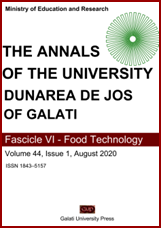Phenolic compounds from artichoke (Cynara scolymus L.) byproducts: optimization of microwave assisted extraction and enrichment of table oil
Abstract
The present study deals with the optimization of phenolic compounds extraction from artichoke (Cynara scolymus L.) waste, and development of a functional enriched edible oil with potential health promoting effects.. Box–Behnken Design (BBD), a widely used form of response surface methodology (RSM), was applied to investigate the effect of process variables on the microwave-assisted extraction (MAE) for the recovery of total phenolic compounds (TPC). Independent variables including ethanol concentration (%), microwave power (W), irradiation time (min), solvent-to-material ratio (mL/g) for MAE were studied. The statistical analysis revealed that the optimal MAE conditions were obtained with 72 % ethanol as extraction solvent, 81:1 mL/g of solvent/solid ratio, 4 min and 900 W for irradiation time and power, respectively. Maximum predicted TPC recovery under the optimized conditions was 37.43 ± 1.26 mg GAE/g DW, which was close to the experimental value 36.10 ± 0.72, indicating suitability of the employed model and the success of RSM in optimizing the extraction conditions. The TPC confirmed the efficiency of MAE methods when compared with the conventional method. The studied edible oil enriched with the optimized extract had a content of phenolic compounds equivalent to 56.41 ± 2.03 μg/mL compared to the control oil.


